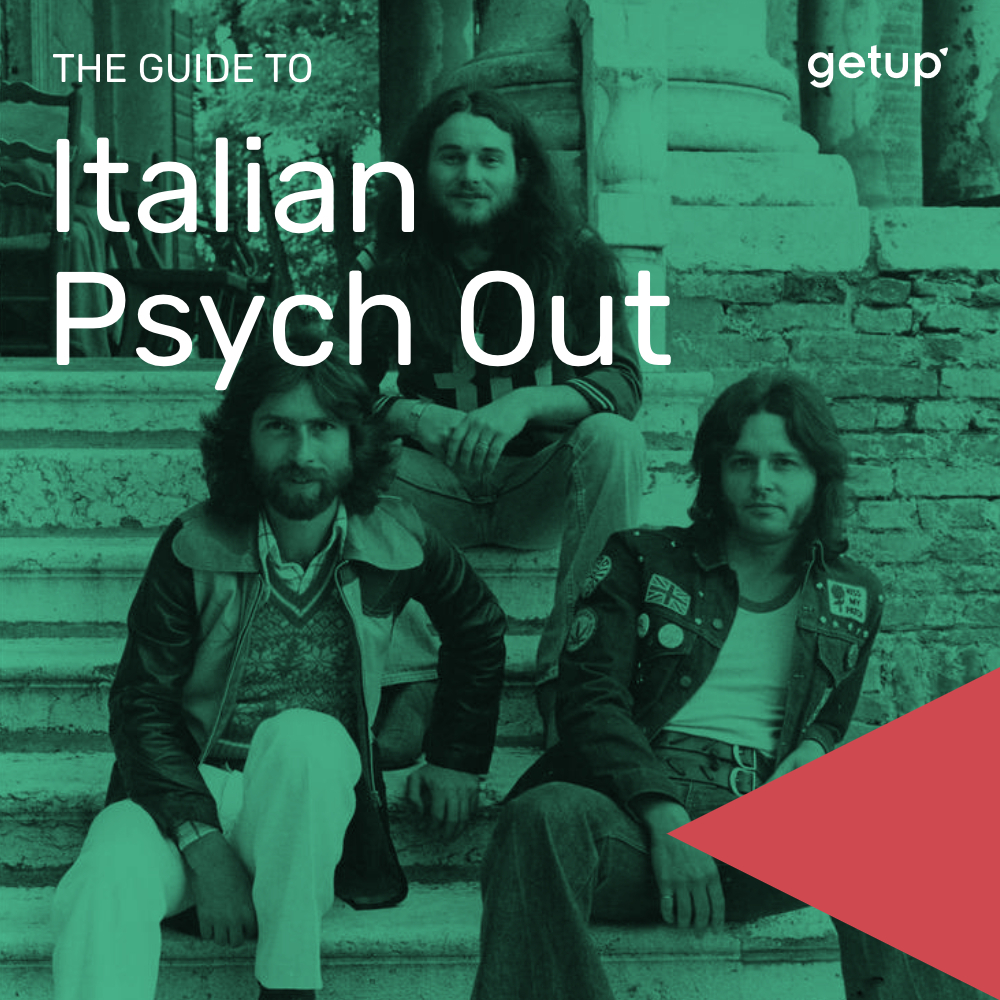Rome, it’s the night of February 15th, 1965 and an eclectic hoard of long-haired teens, Roman upper-class kids and showbiz faces cram down a narrow staircase in Via Tagliamento. In a basement at number 9, lawyer Alberigo Crocetta has just opened the doors of Piper Club, a futuristic open space with a never-seen-before soundsystem by RCA, psychedelic lightshows and bright-coloured, monochrome plastic furniture. From that night on until the end of the decade, the unsettling Quartiere Coppedè – later to become the trademark setting of many of Dario Argento’s finest giallo and horror films – would see its sidewalks filled with young beatniks.
Although Beatlemania had already spread to Italy by 1964, it wasn’t until the Fab4’s ’65 Italian tour and the opening of Piper Club that beat music and culture didn’t escalate to a nationwide fever. Just like in the US, beat bands of all sorts bloomed all over Italy. From melodic and early Beatles-inspired acts to wild garage punkers, Italian beat portraited a season of teenage excitement and previously unseen social change. Piper Club, with its Torino and Viareggio branches, became the quintessential symbol of 1960s Italian widespread wealth and of its beat generation. Its stage, along radio show Bandiera Gialla and magazines Giovani, Ciao 2001 and Big, contributed to spread beat music, aesthetics and way of life throughout a nation that although united was still culturally strongly divided. Frequent became the episodes of teenagers fleeing their homes to join communes or to chase the beat hitchhiking dream – on the style of Jack Kerouac’s On the Road and French troubadour Antoine’s songs like “Autoroute Européenne N°4”, “Je Reprends la Route Demain” and ‘Une Autre Autoroute’.
Piper Club undoubtedly looked beyond Italian borders, taking inspiration from London hip nightclubs and hosting emerging hot foreign acts and future legends such as Jimi Hendrix, Pink Floyd, Byrds, Small Faces, Procol Harum and Donovan among others. Undoubtedly the British Invasion thoroughly influenced the Italian pop culture of the times, to the point that the country became a land of opportunity for English musicians who were finding it hard to top the charts in their motherland. Not only long hair and British accent were considered an arm of seduction, but Her Majesty’s men were seen by European record labels as an unmissable opportunity, the closest Italy could get to Jagger and Lennon. Mal Ryder – with his cheesy British-twanging Italian – and The Rokes were probably the luckiest of the expats, reaching fame levels even superior to many foreign bands. Because of their better technique forged in years of gigging, many British beatniks found their way as touring musicians – some with better luck like Cyan Three who became Patty Pravo’s band, others with much less fortune, like The Stars, whose members returned to England with less money than when they left for Europe. Foreign inspiration was undoubtedly essential to Italian beat, to the extent that most hit singles were covers of British or American songs, sometimes even performed by multiple acts with different lyrics adaptions. Take I Pooh and Evy’s versions of The Spencer Davis Group’s hit “Keep on Running” – both included in the playlist.
If Piper Club mostly represented the mainstream side of the beat generation, it was the provincial underworld of garage-punkers that made Italian beat truly fascinating. Take I Ragazzi del Sole’s original “Atto di Forza Numero 10” – a raw number about youth gang violence, that portrays in the sound as much as in the lyrics the black leather, metal chains and motorbikes imagery of cult film The Wild Angels.
Peculiar to Italian beat was the ironical and irreverent, sometimes political, nature of lyrics. Although most numbers covered the evergreen topic of love, songs like “Il Mio Amore è un Capellone”, “Ma Che Colpa Abbiamo Noi”, “I Capelloni”, “Come Potete Giudicar” fought - some more ironically than others - the stereotype of long hair, which in a deeply conservative and catholic Italy were seen as a big issue. The generational clash between long-haired ‘capelloni’ and stricts ‘matusa’ (a slang word used to identify mature people, as old as Methuselah) by the mid-60s was setting the public opinion of fire, inevitably fuelling comedy sketches and parody songs too. Other interesting lyrics certainly include “La Libertà” by I Camaleonti. Despite being a Monkees cover, the track was a rather unique criticism to property speculation. Also worth of mention is Bad Boys’ “Quel Ragazzo Triste Sono Io”, a tongue-in-cheek reply to Patty Pravo’s “Ragazzo Triste’”– possibly one of the manifesto songs of the whole Italian beat scene.
Many future pop stars, like Renato Zero – here at his recording debut with a cover of The Bystanders’ “98.6” – moved their first steps in the music industry during these years. Regardless of the music, beat culture represented a kind of social revolution where everybody – from youth to parents, from bourgeoises to working class kids – were involved. Piper Club, most of everything, managed to break down class differences, bringing people together in the name of a shared culture, before politics and violence took the helm of Italy at the turn of the decade.
.jpg)






